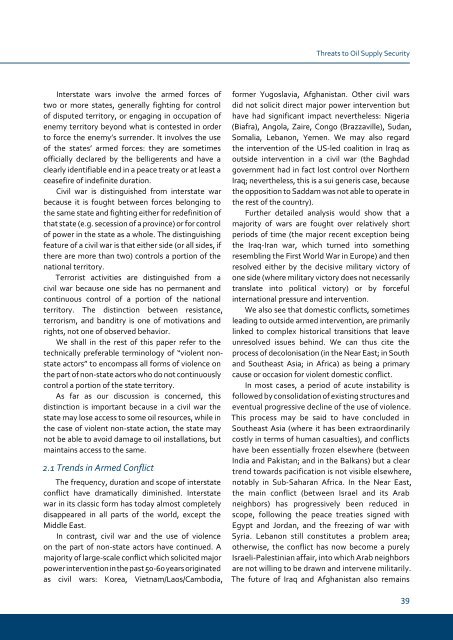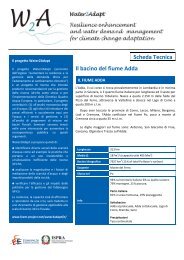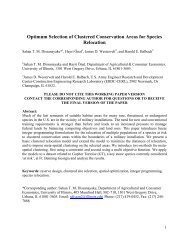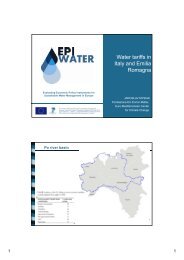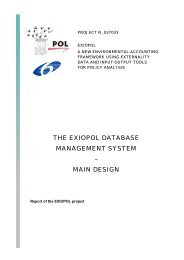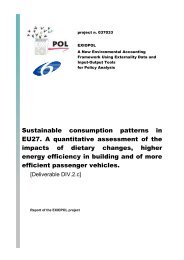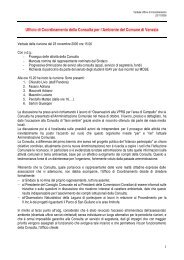Gulf and European Energy Supply Security - Feem-project.net
Gulf and European Energy Supply Security - Feem-project.net
Gulf and European Energy Supply Security - Feem-project.net
Create successful ePaper yourself
Turn your PDF publications into a flip-book with our unique Google optimized e-Paper software.
Interstate wars involve the armed forces of<br />
two or more states, generally fighting for control<br />
of disputed territory, or engaging in occupation of<br />
enemy territory beyond what is contested in order<br />
to force the enemy’s surrender. It involves the use<br />
of the states’ armed forces: they are sometimes<br />
officially declared by the belligerents <strong>and</strong> have a<br />
clearly identifiable end in a peace treaty or at least a<br />
ceasefire of indefinite duration.<br />
Civil war is distinguished from interstate war<br />
because it is fought between forces belonging to<br />
the same state <strong>and</strong> fighting either for redefinition of<br />
that state (e.g. secession of a province) or for control<br />
of power in the state as a whole. The distinguishing<br />
feature of a civil war is that either side (or all sides, if<br />
there are more than two) controls a portion of the<br />
national territory.<br />
Terrorist activities are distinguished from a<br />
civil war because one side has no permanent <strong>and</strong><br />
continuous control of a portion of the national<br />
territory. The distinction between resistance,<br />
terrorism, <strong>and</strong> b<strong>and</strong>itry is one of motivations <strong>and</strong><br />
rights, not one of observed behavior.<br />
We shall in the rest of this paper refer to the<br />
technically preferable terminology of “violent nonstate<br />
actors” to encompass all forms of violence on<br />
the part of non-state actors who do not continuously<br />
control a portion of the state territory.<br />
As far as our discussion is concerned, this<br />
distinction is important because in a civil war the<br />
state may lose access to some oil resources, while in<br />
the case of violent non-state action, the state may<br />
not be able to avoid damage to oil installations, but<br />
maintains access to the same.<br />
2.1 Trends in Armed Conflict<br />
The frequency, duration <strong>and</strong> scope of interstate<br />
conflict have dramatically diminished. Interstate<br />
war in its classic form has today almost completely<br />
disappeared in all parts of the world, except the<br />
Middle East.<br />
In contrast, civil war <strong>and</strong> the use of violence<br />
on the part of non-state actors have continued. A<br />
majority of large-scale conflict which solicited major<br />
power intervention in the past 50-60 years originated<br />
as civil wars: Korea, Vietnam/Laos/Cambodia,<br />
Threats to Oil <strong>Supply</strong> <strong>Security</strong><br />
former Yugoslavia, Afghanistan. Other civil wars<br />
did not solicit direct major power intervention but<br />
have had significant impact nevertheless: Nigeria<br />
(Biafra), Angola, Zaire, Congo (Brazzaville), Sudan,<br />
Somalia, Lebanon, Yemen. We may also regard<br />
the intervention of the US-led coalition in Iraq as<br />
outside intervention in a civil war (the Baghdad<br />
government had in fact lost control over Northern<br />
Iraq; nevertheless, this is a sui generis case, because<br />
the opposition to Saddam was not able to operate in<br />
the rest of the country).<br />
Further detailed analysis would show that a<br />
majority of wars are fought over relatively short<br />
periods of time (the major recent exception being<br />
the Iraq-Iran war, which turned into something<br />
resembling the First World War in Europe) <strong>and</strong> then<br />
resolved either by the decisive military victory of<br />
one side (where military victory does not necessarily<br />
translate into political victory) or by forceful<br />
international pressure <strong>and</strong> intervention.<br />
We also see that domestic conflicts, sometimes<br />
leading to outside armed intervention, are primarily<br />
linked to complex historical transitions that leave<br />
unresolved issues behind. We can thus cite the<br />
process of decolonisation (in the Near East; in South<br />
<strong>and</strong> Southeast Asia; in Africa) as being a primary<br />
cause or occasion for violent domestic conflict.<br />
In most cases, a period of acute instability is<br />
followed by consolidation of existing structures <strong>and</strong><br />
eventual progressive decline of the use of violence.<br />
This process may be said to have concluded in<br />
Southeast Asia (where it has been extraordinarily<br />
costly in terms of human casualties), <strong>and</strong> conflicts<br />
have been essentially frozen elsewhere (between<br />
India <strong>and</strong> Pakistan; <strong>and</strong> in the Balkans) but a clear<br />
trend towards pacification is not visible elsewhere,<br />
notably in Sub-Saharan Africa. In the Near East,<br />
the main conflict (between Israel <strong>and</strong> its Arab<br />
neighbors) has progressively been reduced in<br />
scope, following the peace treaties signed with<br />
Egypt <strong>and</strong> Jordan, <strong>and</strong> the freezing of war with<br />
Syria. Lebanon still constitutes a problem area;<br />
otherwise, the conflict has now become a purely<br />
Israeli-Palestinian affair, into which Arab neighbors<br />
are not willing to be drawn <strong>and</strong> intervene militarily.<br />
The future of Iraq <strong>and</strong> Afghanistan also remains


